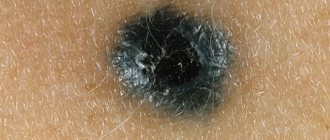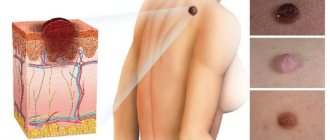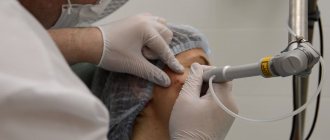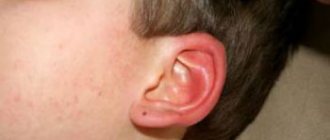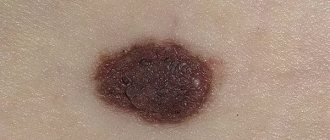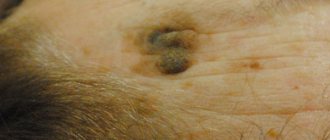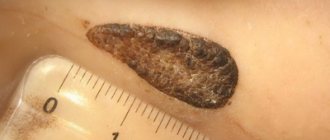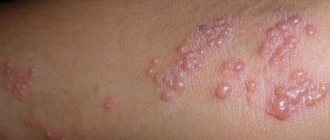The process of tearing off a mole is quite unpleasant, but it is much worse when the mole falls off on its own. Of course, the presence of a birthmark does not entail a terrible diagnosis, but when this kind of growth on the body disappears spontaneously, then this is a reason to contact a specialist.
When a growth on the body falls off spontaneously, this is a reason to contact a specialist.
Causes
Why did the mole fall off? Numerous factors can influence this. But most often there are two reasons. The first is that the mole has dried out and fallen off. As a rule, this occurs with a papilloma or birthmark. This phenomenon may occur due to hormonal imbalance.
The second reason lies in the fact that first the mole turns black and then is rejected. This symptom is very bad. As a rule, those formations that degenerate into malignant neoplasms turn black. A mole can also become black after its integrity has been damaged as a result of injury. Be sure to consult a doctor, even if after the growth has fallen off you have not left behind any redness, swelling or inflammation.
What are moles?
Birthmarks are usually called some congenital or acquired skin defects that are formed as a result of a certain proliferation of the epithelium of the skin containing the melanin pigment. Congenital moles can appear in a person several months after birth. Acquired ones arise at different periods of life, manifesting themselves especially intensely during certain hormonal changes. Moles are considered benign formations that, in most cases, are not prone to the development of oncological processes. However, dermatologists strongly recommend monitoring their changes.
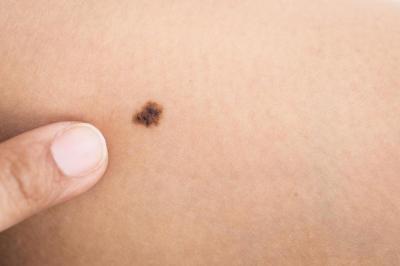
But no need to worry. Statistics show that skin cancer develops from areas of the skin that do not contain birthmarks in eighty percent of cases, and only twenty percent develops from them.
Nevertheless, a very serious reason to visit a medical institution for the purpose of consultation is the situation when a mole has fallen off. This is not always evidence of skin diseases. However, it is better to play it safe, undergo appropriate diagnostics and identify the causes of this circumstance.
It is worth remembering that skin cancer diagnosed in time can be successfully cured without leaving any health consequences. Advanced cases are difficult to treat and even lead to death.
Why does the nevus come off piece by piece?
Can a mole fall off on its own into separate elements? The partial disintegration of a mole may be influenced by the following reasons:
Partial disintegration of the mole is also possible.
- A mole and a solarium are two interrelated phenomena. There is a disturbed blood supply to the nevus, which occurs after intense exposure to UV radiation.
- Malignant transformation of the growth into melanoma. In this case, redness, peeling and soreness of the skin may occur in the place where the nevus has dried out and erupted.
In any of the cases under consideration, the patient must contact an oncologist, who will check the moles and take biological material for histological examination.
What do safe moles look like?
There are several basic characteristics that distinguish a harmless accumulation of cells from a true malignancy:
- clear symmetry, “neat” edges and smooth border;
- uniform pigmentation of the mole (a shade slightly darker than the overall skin color), pink, bluish, or light tones should not be present;
- absence of growth or any other change in the appearance of the tumor.
To protect yourself from possible problems, try to follow these simple tips:
- do not stay in direct sunlight for a long time;
- refuse solarium;
- Monitor nevus carefully if any close relatives have had melanoma;
- If a mole gets in the way or is often touched by clothes or accessories, think about the need to remove it.
When a fallen mole is a sign of cancer
The study of moles in medical practice has made it possible to identify the following symptoms, according to which they can transform into cancerous tumors:
- Change in the shape and size of the neoplasm. If a mole becomes cancerous, it becomes dark and affects a large area of the body.
- Peeling increases and severe itching occurs in the area where the formations are located.
- Formation of bleeding ulcers and erosions.
- Painful sensations, the intensity of which increases each time.
A mole has fallen off - a red spot remains
A red spot at the site of the mole remains after its removal or after it has fallen off on its own. In this case, it is not recommended to do anything. Over time, skin cells will regenerate and the red spot will disappear or become lighter.
The alarm should be sounded when a red spot after a mole causes pain, itches, tingles, or a new growth of an unknown nature appears in it. It is worth urgently making an appointment with an oncologist and taking the appropriate tests so as not to miss the onset of melanoma.
Diagnostics
The type of nevus can be detected using ultrasound
If the mole begins to dry out and fall off, then you need to seek help from a doctor. In this case, a dermatologist can help you. He will examine the growth, discover its origin and prescribe treatment. Diagnosis will include digital dermatoscopy. This manipulation includes a visual examination of the tumor using a dermatoscope. Such a study makes it possible to study education and determine what type it belongs to.
The type of nevus can be detected using ultrasound. With its help, you can understand the depth of the growth and determine the reason for its formation. After the manipulation, the doctor can choose an effective treatment method. This may include laser or surgical intervention.
Forecast and what to expect?
If a mole has fallen off, then you should not immediately panic, but soberly assess the situation and make an appointment with a doctor! This is not yet 100% malignant. Only appropriate analyzes can clarify the situation. But there are 3 factors that can add “optimism”:
- Patient's gender. Women are less likely to get skin cancer than men.
- Moles on the hands are mostly benign.
- You can examine a nevus and get final answers to all your questions only in a professional clinic with an experienced oncologist.
Therapy methods
If a strange mole has been discovered or an injury has occurred, you should visit a doctor as soon as possible. But the first step is to carry out a number of simple measures that will prevent the development of complications.
When a mole comes off entirely
If a mole falls off, it is first necessary to stop the bleeding and disinfect the wound. This will prevent the infection from penetrating into it, therefore, blood infection will not occur. The action plan boils down to the following:
- Apply a sterile bandage to the area from which the mole fell off. If the blood loss is profuse, then the dressings must be changed frequently.
- Then apply a strong antiseptic solution - Chlorhexidine. It is necessary to saturate the bandage with it and apply it to the growth site for 5 minutes.
- Cover the wound with a bactericidal plaster and visit a doctor.
- It is necessary to go to the hospital with a growth that had to be torn off. To do this, store it in a pharmaceutical saline solution.
When a mole is torn
If a hanging mole is torn off, it will be injured and will not come off completely. Then it must be properly processed and immediately sent to a specialist. The procedure is as follows:
- If the formation could not fall off, but after its injury blood is visible, then it is necessary to treat it with perhydrol, and then with chlorhexidine. If the damage is not accompanied by bleeding, then only chlorhexidine can be applied.
- Cover the area where the growth is concentrated with a bactericidal plaster. And then visit the oncologist-surgeon's office.
The doctor will examine the pathological neoplasm and make a conclusion regarding its structure and features. Then the nevus is removed by any suitable method, and the removed growths are sent for histological examination.
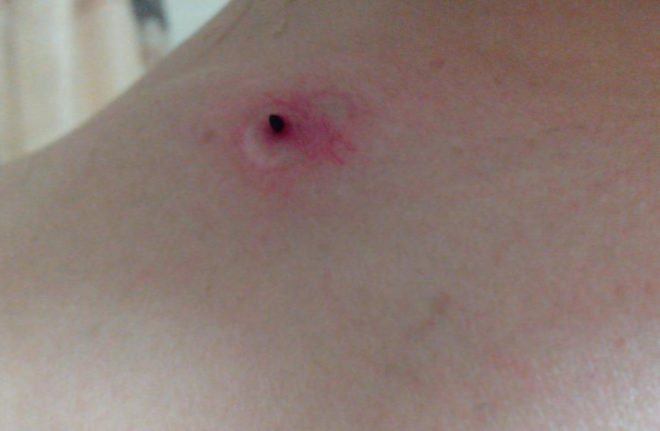
If a mole falls off, it is first necessary to stop the bleeding and disinfect the wound
Laser method
After laser treatment, there are no scars or scars on the skin. It is for this reason that this manipulation has become in demand when removing moles that are concentrated on the face, neck and hands.
The essence of the method is that the nevus cells are influenced by a laser beam, which allows the mole to dry out. But after this, a small, non-pigmented spot appears at the site of the nevus. During excision, the laser beam seals small vessels, so that after this there are no serious complications in the form of inflammation or burns.
Cryodestruction
The procedure is carried out under the influence of liquid nitrogen, as a result of which the growth cells die. Over time, the crust after manipulation should dry out and fall off. Healthy tissue appears in place of the nevus. This method of therapy is used when it comes to flat and small growths. But deep-planted “roots” of a nevus cannot be treated in this way.
The advantage of cryodestruction remains the absence of pain, as well as the absence of excision of healthy tissue located near the growth.
Electrocoagulation
Electrocoagulation is used in the treatment of blackened moles
This method of therapy is used in the treatment of blackened moles. The formation on the skin is burned off under the influence of high temperatures. And then a black film remains. It takes time for it to dry out and fall off on its own. Until this time, touching the treatment area is prohibited.
During manipulation, only tumor cells are affected. In this case, nearby capillaries are sealed and disinfected, which indicates the advantages of this method over surgical intervention.
Each person has a certain number of moles on their body, which differ in area of concentration and size. But there are situations when the growths disappear, and they can fall off completely or partially. At home, you can only disinfect and stop the bleeding, and then you need to urgently go to the hospital to prevent the development of oncology.
The mole has crusted over and fallen off
- 01 August
- 0 rating
Moles are congenital or acquired spots on the body of different sizes, structures and colors. They don't bother you until they start behaving dynamically. Sometimes they change shape or increase in size so that clothes begin to touch them. If a crust appears on a mole, this may signal a modification of hormones in the body that adversely affect health.
Reasons for the appearance of a crust on a mole
All birthmarks appear under the influence of changes in pigmentation and vascular system. Deformation serves as a signal to visit a doctor. The appearance of a crust on a mole is influenced by several reasons:
- mechanical injury;
- constant touching by clothes;
- getting burned;
- hormonal disorders leading to pathology.
A crust on a mole is not always a precursor to cancer. If it appears during an injury or burn, there is no health risk. Here it is necessary to eliminate the entry of pathogenic microorganisms into the wound so as not to aggravate the course of the disease.
The following symptoms indicate the possibility of developing cancer:
- hair on the formation began to fall out;
- redness of the area around the birthmark;
- secretion of lymphatic fluid;
- burning, itching, tingling;
- change in density.
If a mole has crusted over or enlarged, what does this mean, a dermatologist or oncologist can answer. Therefore, if you experience any of the above symptoms, you should immediately visit a specialist.
What to do if a mole has crusted over
Normal moles look like small, dark, round spots. They can be on the back, arms, stomach, neck and other parts of the body. Flat nevi are considered the most harmless. All others require a thorough examination.
The following growths require medical attention:
- Rapidly increasing in size over 6 mm.
- They have an asymmetrical shape.
- Ragged edges.
- If there is pain.
- The appearance of dryness.
- If you start bleeding.
A birthmark that has become crusted over should absolutely not be touched. Do not apply medicated ointments or lotions with medications to soften the top layer. You cannot use traditional recipes for removal. This will not only help, but will also make the problem worse.
The color of the top layer can tell a specialist a lot:
- brown color indicates that the mole was injured and began to heal;
- black color remains on the area of the removed growth;
- a gray, yellow tint indicates the beginning of rebirth.
The crusts must not be torn off or scratched. They must be carefully hidden from bright ultraviolet rays. It is not advisable to keep all birthmarks in direct sun for a long time. If the skin begins to bleed, you should immediately visit a doctor.
Diagnostic and treatment methods
Therapy is prescribed only after diagnosis. Diagnostic methods are as follows:
- visual study of shape, color, size;
- taking a smear in the area of the growth;
- The discharge under the crust is taken for examination;
- computer modeling is carried out;
- fluorescence microscopy;
- biopsy of a piece of tissue for microscopic examination;
- a blood test is taken for tumor markers, which determines whether the growth is benign or malignant;
- prescribing adequate treatment.
You can carry out self-monitoring using the American Melanoma Accord system. Thanks to this system, everyone can recognize dangerous changes at an early stage. The procedure is carried out in several steps:
- “A” is the presence of asymmetry in birthmarks;
- “K” – state of the ends of the build-up;
- “K” – blurred edges, characteristic of a malignant form of oncology;
- “O” – study of color distribution, color change in relation to the original state;
- “P” – dynamic increase in size, diameter over 5 – 6 mm indicates the development of skin cancer;
- “D” - intensive growth dynamics, changes in structure, the presence of a crust and other changes are included in this parameter.
Therapy directly depends on the transformation of the mole into melanoma.
MethodologyWays of treatment
| Radiosurgery | Radiation therapy is carried out using a radioknife. This is a non-traumatic method in which the resulting crust falls off after a week. |
| Laser removal | A safe and painless method that leaves no traces. After removing a mole with a powerful light beam, the top layer disappears after 14–20 days. |
| Surgical intervention | The method is ideal for large, hanging birthmarks that are dangerous. There may be a scar that takes a month to heal. |
| Electrocoagulation | Removal using current. A medical coagulator is used. After such an operation, it is possible to study the cut material. |
| Cryodestruction | A thin needle with a temperature sensor is inserted into the growth, then cooled to the desired temperature and abruptly removed. Freezing occurs with liquid nitrogen. With this method, a crust is formed that lasts about 30 days. |
If there is a crust on a birthmark, you should not immediately panic, tear it off or treat it yourself. Be sure to visit a doctor to make a diagnosis and prescribe treatment. Not all cases require mole removal, and timely examination can save lives.
https://www.youtube.com/watch?v=4q_FgHF7-II
A mole is a benign formation that is present on the body of almost every person. The scientific name for this phenomenon is nevus.
If the mole has the correct shape and does not cause discomfort, you can lead a full life with it. There is no need to remove it.
What to do if a mole has crusted over? What does it mean? Any changes in the nevus are a reason to consult a dermatologist.
Treatment
The method of treating a damaged nevus is selected by the doctor based on research results. A benign lesion usually does not require treatment, with the exception of wound care. It consists of careful treatment with antiseptics, and later in the use of wound-healing external agents.
If the mole was cancerous, a specialist may recommend surgery to remove any remaining abnormal cells .
For this we use:
- laser. The least traumatic and safe method that can be used on any part of the body, including the face and mucous membranes;
- cryodestruction. Liquid nitrogen or carbonic acid ice is used to destroy nevus cells. Suitable only for small flat formations;
- electrocoagulation. Burning with an electric knife is indicated for removing blackened moles. Not suitable for large nevus size;
- radio wave method. An effective, low-traumatic, but not very common method:
- surgical scalpel. Allows you to completely remove all pathological cells. The method is suitable in all cases, however, it has a significant drawback: a high risk of scar formation.
In addition, malignant tumors at the initial stage require the administration of immunomodulating drugs based on interferon. They are able to prevent the growth of diseased cells and stop metastasis. Additionally, anti-inflammatory and antitoxic drugs and herbal medicine are used.
Note! If a mole has turned black, dried out, or fallen off, this cannot be the norm! No self-medication, traditional medicine or other amateur activities! Only disinfection and immediate medical attention!
A mole that has fallen off is a reason to go to the hospital as soon as possible, the first alarming symptom of the appearance of a neoplasm (cancerous tumor). To confirm the diagnosis, the growth will be examined and treatment will be prescribed.
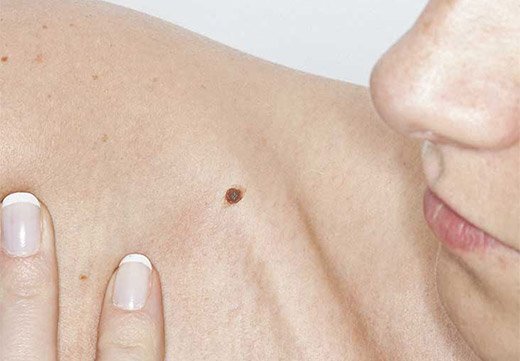
Nevus decay
You can often see how the nevus does not disappear completely, but seems to crumble. Before this, it may increase in size. This happens due to prolonged exposure to the sun, microtrauma, and frequent contact with clothing. The pieces that fall off make us nervous and panicky. Don't sound the alarm prematurely! Try to collect pieces of the nevus and take them to the doctor. Be sure to see a gynecologist and dermatologist. If the nevus simply falls off without pain, there is nothing to worry about - the body does not supply nutrients to this formation. Melanoma can be treated in the early stages; the main thing is to detect the disease in time.

Hanging nevi cause a lot of trouble: they often rub against clothes. Unsightly growths can be removed surgically. If the nevus peels off and falls off, this is an alarming signal. Sometimes neoplasms become dangerous to health. When a nevus peels, itches, dries out, and then falls off, this is a sign of a malignant tumor. If you see that it is crumbling, there is a high probability of transformation into melanoma (the doctor recommends removal).
In any case, you need to contact a specialist. A dangerous neoplasm has asymmetrical outlines, fuzzy, uneven edges. Its size is more than 6 mm. Throughout life, a malignant mole changes in color and size. A normal nevus has clear, smooth edges and its diameter is less than 6 mm. The color of such a mole is not too dark, the color is uniform. To exclude the possibility of melanoma, you need to consult a doctor, otherwise the consequences will be unpredictable.
